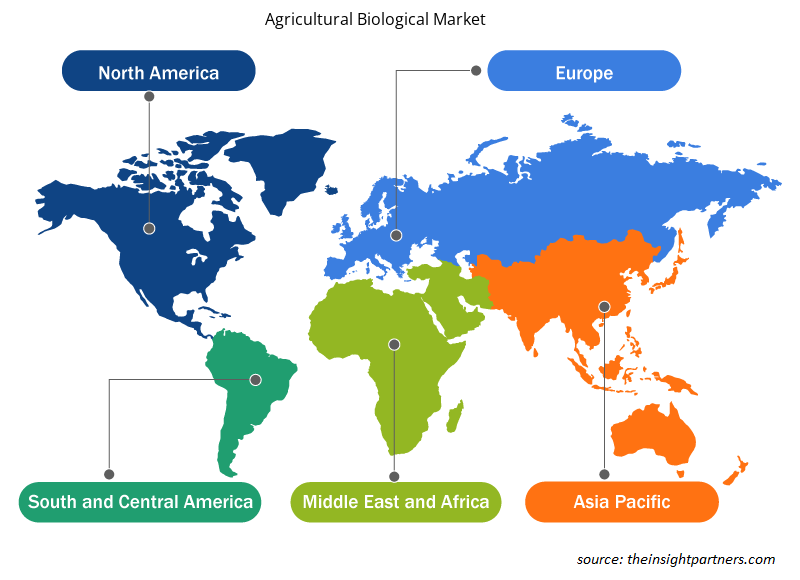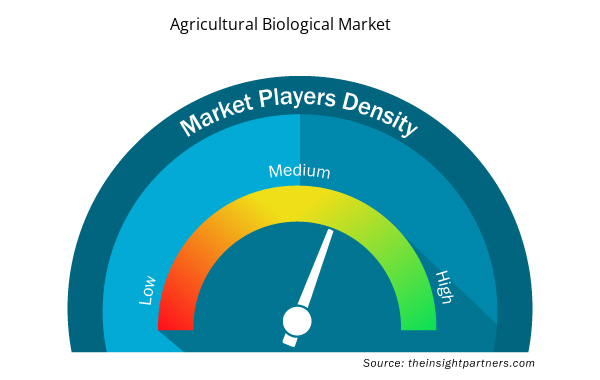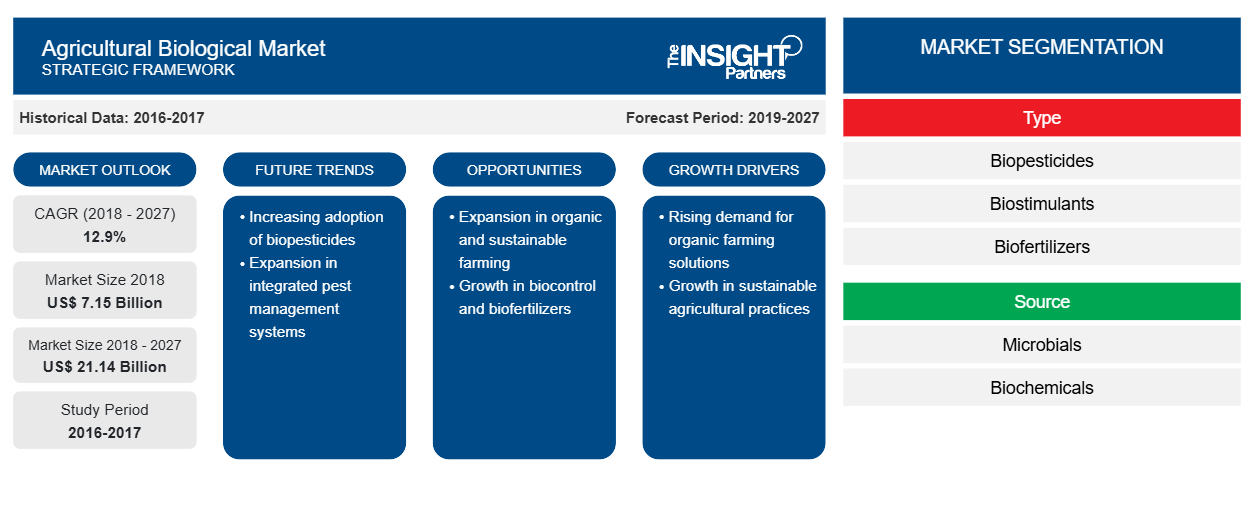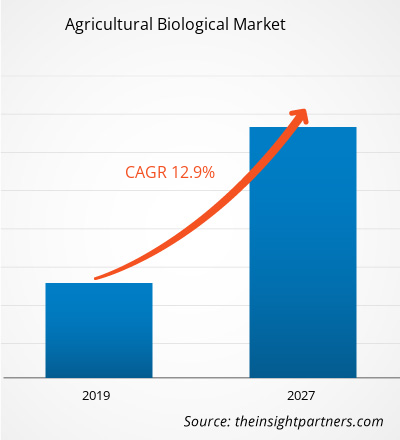[調査レポート] 農業生物市場は2018年に7,148.8百万米ドルに達し、2019年から2027年の予測期間中に12.9%のCAGRで成長し、2027年までに21,141.0百万米ドルに達すると予想されています。
北米地域は、世界の農業生物市場で最大の市場シェアを占めています。この地域の農業生物市場の成長は、主に消費者のオーガニック食品への嗜好の変化と研究開発活動への投資の増加、持続可能な慣行の促進に向けた政府の好ましい取り組み、健康意識の高まりに起因しており、これらが北米地域の市場を牽引する主な要因となっています。
市場分析
合成製品よりも天然製品の採用が増えたことで、農業生物市場の成長につながった。
農業生物製品は、化学農薬、殺菌剤、殺虫剤などの合成または化学的な植物保護製品の代替品としてますます使用されています。生物農薬、生物刺激剤、生物肥料などの農業生物製品は、土壌の健全な発達、植物の病気の抑制、栄養吸収の強化、植物の成長の強化など、さまざまな効果をもたらす天然製品として機能します。農業生物製品の需要は、コストが最小限で、環境への影響が少なく、害虫に対する製品耐性のリスクが低いため、他の合成製品よりも高まっています。
アジア太平洋地域における健康食品の需要の高まりは、世界の農業生物市場の成長機会を生み出すでしょう。
中国、インド、日本、韓国などの先進国では、より健康的な農作物食品に対する意識と需要が高まっており、メーカーによる農業生物製品の製造が促進されています。また、アジア太平洋地域の発展途上国では、ライフスタイルの変化、中流階級人口の増加、可処分所得の増加、より健康的な製品に対する意識の高まりにより、農業生物製品に大きな可能性と成長の見通しが示されています。
要件に合わせてレポートをカスタマイズする
このレポートの一部、国レベルの分析、Excelデータパックなど、あらゆるレポートを無料でカスタマイズできます。また、スタートアップや大学向けのお得なオファーや割引もご利用いただけます。
- このレポートの主要な市場動向を入手してください。この無料サンプルには、市場動向から見積もりや予測に至るまでのデータ分析が含まれます。
アプリケーションモードの洞察
適用モードに基づいて、世界の農業生物市場は、葉面散布、土壌処理、種子処理に分類されています。種子処理セグメントは、世界の農業生物市場につながりました。種子は、種子媒介病原体から保護するために、殺虫剤、殺菌剤などの助けを借りて処理されます。種子はまた、太陽エネルギーにさらされたり、調整された水に浸されたりします。それは、発芽の改善、土壌に存在する昆虫の防除、植物病の予防、早期成長と定着、苗枯れや種子腐敗からの保護など、さまざまな利点をもたらします。種子は、種子ドレッシング、種子ペレット化、種子コーティングなどのさまざまな手順で処理できます。
ソースインサイト
世界の農業生物市場は、その供給源に基づいて、微生物、生化学薬品、その他に分かれています。微生物セグメントは、世界の農業生物市場で最大のシェアを占めています。微生物は、真菌、細菌、ウイルス、原生動物などに分類できる小さな細菌および真菌の生物です。微生物は土壌の栄養吸収を改善し、病気から保護するための害虫駆除を提供し、収穫量を高めます。窒素、カリウム、リン、硫黄などの必須栄養素の吸収を助け、植物の健康管理、作物の生産性、土壌の健康維持などの基本的な農業問題、および無機および有機汚染物質からの土壌と水のバイオレメディエーションなどの環境問題の解決で広く知られています。
合併や買収、新製品開発などが、世界の農業生物市場で最も採用されている戦略として観察されました。世界の農業生物市場における最近の動向のいくつかを以下に示します。
- 2018年:BASF SEは、種子プラットフォームを強化し、最近拡大した農業ソリューションポートフォリオを補完するために、Bayer AGの買収を完了しました。
- 2018年:Koppert Biological Systemsは最近、カリフォルニアのイチゴ市場に新しいNatuGro Systemを導入すると発表しました。
- 2018年:Marrone Bio Innovations, Inc. は、新しいグローバルな生物学的土壌施用および種子処理プラットフォームである TerraConnect を立ち上げ、栽培者に高性能製品と、作物の改善と保護に役立つ幅広いツールを提供しています。
農業生物製剤
農業生物市場地域別洞察
予測期間を通じて農業生物市場に影響を与える地域的な傾向と要因は、Insight Partners のアナリストによって徹底的に説明されています。このセクションでは、北米、ヨーロッパ、アジア太平洋、中東、アフリカ、南米、中米にわたる農業生物市場のセグメントと地理についても説明します。

- 農業生物市場の地域別データを入手
農業生物市場レポートの範囲
| レポート属性 | 詳細 |
|---|---|
| 2018年の市場規模 | 71.5億米ドル |
| 2027年までの市場規模 | 211.4億米ドル |
| 世界のCAGR(2018年 - 2027年) | 12.9% |
| 履歴データ | 2016-2017 |
| 予測期間 | 2019-2027 |
| 対象セグメント | タイプ別
|
| 対象地域と国 | 北米
|
| 市場リーダーと主要企業プロフィール |
|
農業生物市場プレーヤーの密度:ビジネスダイナミクスへの影響を理解する
農業生物市場は、消費者の嗜好の変化、技術の進歩、製品の利点に対する認識の高まりなどの要因により、エンドユーザーの需要が高まり、急速に成長しています。需要が高まるにつれて、企業は提供を拡大し、消費者のニーズを満たすために革新し、新たなトレンドを活用し、市場の成長をさらに促進しています。
市場プレーヤー密度とは、特定の市場または業界内で活動している企業または会社の分布を指します。これは、特定の市場スペースに、その市場規模または総市場価値に対してどれだけの競合相手 (市場プレーヤー) が存在するかを示します。
農業生物市場で事業を展開している主要企業は次のとおりです。
- BASF SE
- ビオルヒム SpA
- セルティスUSA LLC
- ダウ・デュポン社
- イサグロ SpA
免責事項:上記の企業は、特定の順序でランク付けされていません。

- 農業生物市場のトップキープレーヤーの概要を入手
世界の農業生物市場のセグメンテーション
タイプ別
• 生物農薬• 生物刺激剤• 生物肥料
出典別
• 微生物• 生化学物質• その他
アプリケーションモード別
• 葉面散布• 土壌処理• 種子処理
アプリケーション別
• 穀類• 油糧種子および豆類• 果物および野菜• その他
地理別
北米
- 私たち
- カナダ
- メキシコ
ヨーロッパ
- ドイツ
- フランス
- イタリア
- 英国
- ロシア
- その他のヨーロッパ
アジア太平洋
- オーストラリア
- 中国
- インド
- 日本
- 韓国
- その他のアジア太平洋地域
中東およびアフリカ(MEA)
- 南アフリカ
- サウジアラビア
- アラブ首長国連邦
- MEAの残り
南アメリカ
- ブラジル
- アルゼンチン
- 南米のその他の地域 (SAM)
企業プロフィール
- BASF SE
- ビオルヒム SpA
- セルティスUSA LLC
- ダウ・デュポン社
- イサグロ SpA
- コッパート生物システム
- マローネバイオイノベーションズ株式会社
- シンジェンタ
- UPL
- ヴァレントバイオサイエンスLLC
- 過去2年間の分析、基準年、CAGRによる予測(7年間)
- PEST分析とSWOT分析
- 市場規模価値/数量 - 世界、地域、国
- 業界と競争環境
- Excel データセット


- Identity Verification Market
- Retinal Imaging Devices Market
- Bioremediation Technology and Services Market
- Virtual Production Market
- Vertical Farming Crops Market
- Embolization Devices Market
- Mobile Phone Insurance Market
- Long Read Sequencing Market
- Virtual Event Software Market
- Batter and Breader Premixes Market

Report Coverage
Revenue forecast, Company Analysis, Industry landscape, Growth factors, and Trends

Segment Covered
This text is related
to segments covered.

Regional Scope
North America, Europe, Asia Pacific, Middle East & Africa, South & Central America

Country Scope
This text is related
to country scope.
Trends and growth analysis reports related to Chemicals and Materials : READ MORE..
The List of Companies - Agricultural Biological Market
- BASF SE
- Biolchim S.p.A.
- Certis U.S.A. LLC
- DowDuPont Inc.
- Isagro S.p.A
- Koppert Biological Systems
- Marrone Bio Innovations, Inc.
- Syngenta
- UPL
- Valent BioSciences LLC
The Insight Partners performs research in 4 major stages: Data Collection & Secondary Research, Primary Research, Data Analysis and Data Triangulation & Final Review.
- Data Collection and Secondary Research:
As a market research and consulting firm operating from a decade, we have published and advised several client across the globe. First step for any study will start with an assessment of currently available data and insights from existing reports. Further, historical and current market information is collected from Investor Presentations, Annual Reports, SEC Filings, etc., and other information related to company’s performance and market positioning are gathered from Paid Databases (Factiva, Hoovers, and Reuters) and various other publications available in public domain.
Several associations trade associates, technical forums, institutes, societies and organization are accessed to gain technical as well as market related insights through their publications such as research papers, blogs and press releases related to the studies are referred to get cues about the market. Further, white papers, journals, magazines, and other news articles published in last 3 years are scrutinized and analyzed to understand the current market trends.
- Primary Research:
The primarily interview analysis comprise of data obtained from industry participants interview and answers to survey questions gathered by in-house primary team.
For primary research, interviews are conducted with industry experts/CEOs/Marketing Managers/VPs/Subject Matter Experts from both demand and supply side to get a 360-degree view of the market. The primary team conducts several interviews based on the complexity of the markets to understand the various market trends and dynamics which makes research more credible and precise.
A typical research interview fulfils the following functions:
- Provides first-hand information on the market size, market trends, growth trends, competitive landscape, and outlook
- Validates and strengthens in-house secondary research findings
- Develops the analysis team’s expertise and market understanding
Primary research involves email interactions and telephone interviews for each market, category, segment, and sub-segment across geographies. The participants who typically take part in such a process include, but are not limited to:
- Industry participants: VPs, business development managers, market intelligence managers and national sales managers
- Outside experts: Valuation experts, research analysts and key opinion leaders specializing in the electronics and semiconductor industry.
Below is the breakup of our primary respondents by company, designation, and region:

Once we receive the confirmation from primary research sources or primary respondents, we finalize the base year market estimation and forecast the data as per the macroeconomic and microeconomic factors assessed during data collection.
- Data Analysis:
Once data is validated through both secondary as well as primary respondents, we finalize the market estimations by hypothesis formulation and factor analysis at regional and country level.
- Macro-Economic Factor Analysis:
We analyse macroeconomic indicators such the gross domestic product (GDP), increase in the demand for goods and services across industries, technological advancement, regional economic growth, governmental policies, the influence of COVID-19, PEST analysis, and other aspects. This analysis aids in setting benchmarks for various nations/regions and approximating market splits. Additionally, the general trend of the aforementioned components aid in determining the market's development possibilities.
- Country Level Data:
Various factors that are especially aligned to the country are taken into account to determine the market size for a certain area and country, including the presence of vendors, such as headquarters and offices, the country's GDP, demand patterns, and industry growth. To comprehend the market dynamics for the nation, a number of growth variables, inhibitors, application areas, and current market trends are researched. The aforementioned elements aid in determining the country's overall market's growth potential.
- Company Profile:
The “Table of Contents” is formulated by listing and analyzing more than 25 - 30 companies operating in the market ecosystem across geographies. However, we profile only 10 companies as a standard practice in our syndicate reports. These 10 companies comprise leading, emerging, and regional players. Nonetheless, our analysis is not restricted to the 10 listed companies, we also analyze other companies present in the market to develop a holistic view and understand the prevailing trends. The “Company Profiles” section in the report covers key facts, business description, products & services, financial information, SWOT analysis, and key developments. The financial information presented is extracted from the annual reports and official documents of the publicly listed companies. Upon collecting the information for the sections of respective companies, we verify them via various primary sources and then compile the data in respective company profiles. The company level information helps us in deriving the base number as well as in forecasting the market size.
- Developing Base Number:
Aggregation of sales statistics (2020-2022) and macro-economic factor, and other secondary and primary research insights are utilized to arrive at base number and related market shares for 2022. The data gaps are identified in this step and relevant market data is analyzed, collected from paid primary interviews or databases. On finalizing the base year market size, forecasts are developed on the basis of macro-economic, industry and market growth factors and company level analysis.
- Data Triangulation and Final Review:
The market findings and base year market size calculations are validated from supply as well as demand side. Demand side validations are based on macro-economic factor analysis and benchmarks for respective regions and countries. In case of supply side validations, revenues of major companies are estimated (in case not available) based on industry benchmark, approximate number of employees, product portfolio, and primary interviews revenues are gathered. Further revenue from target product/service segment is assessed to avoid overshooting of market statistics. In case of heavy deviations between supply and demand side values, all thes steps are repeated to achieve synchronization.
We follow an iterative model, wherein we share our research findings with Subject Matter Experts (SME’s) and Key Opinion Leaders (KOLs) until consensus view of the market is not formulated – this model negates any drastic deviation in the opinions of experts. Only validated and universally acceptable research findings are quoted in our reports.
We have important check points that we use to validate our research findings – which we call – data triangulation, where we validate the information, we generate from secondary sources with primary interviews and then we re-validate with our internal data bases and Subject matter experts. This comprehensive model enables us to deliver high quality, reliable data in shortest possible time.


 このレポートの無料サンプルを入手する
このレポートの無料サンプルを入手する